Many successful website owners likely remember staring at their first WordPress sites, wondering if anyone was actually reading the content.
In the beginning, it’s common not to know how to track visitors or understand their behavior. That’s exactly where tools like Google Analytics come in.
Knowing how people interact with your content is key to growing your website. Maybe you want to build a loyal readership. Or maybe you’re trying to increase sales or become an authority in your niche.
Whatever your goal, website traffic data helps you get there. It shows what’s working, what’s not, and where you can improve.
Over the years, we’ve helped countless website owners install Google Analytics on their WordPress sites. Even today, it remains the best way to understand your audience and make smarter decisions.
In this guide, we’ll walk you through the exact steps to install Google Analytics in WordPress. We’ve already done the hard work, so you can set it up without the hassle. 🚀

First, we will explain why Google Analytics is important and how it can help you grow your website.
After that, we will show you how to sign up for a Google Analytics account and different methods to install it on your WordPress site.
Finally, we will explain how to view your traffic reports in Google Analytics.
Here is a quick overview of what you’ll learn in this article:
- Why Is Google Analytics Important for Bloggers?
- How to Sign Up With Google Analytics
- How to Install Google Analytics in WordPress
- Method 1: Google Analytics for WordPress by MonsterInsights
- Method 2: Install Google Analytics in WordPress With WPCode
- Method 3: Install Google Analytics in WordPress Theme
- Viewing Reports in Google Analytics
- Making the Most Out Of Google Analytics
- Video Tutorial
Ready? Let’s get started!
Why Is Google Analytics Important for Bloggers?
Once you start a blog, your #1 goal is to get more traffic and subscribers. Google Analytics helps you make data-driven decisions by showing you the stats that matter. You can see:
Who visits your website?
This part of analytics shows the geographical location of your audience, which browser the user used to visit your site, and other important information such as screen resolution, JavaScript support, Flash support, language, and more.
This data is extremely useful, and it can help in numerous ways. When creating a custom website design, you can use the user data to make sure that your site will be compatible with your audience.
If most of your users don’t have Flash support, then you should avoid adding the Flash element to your site. If most of your users are on 1280 screen resolutions, then make sure that your design is compatible with that resolution or smaller.
What do people do when they are on your website?
You can track where the users are going on your website, how long they stay on your website, and the bounce rate (the percentage of users who exit your site on the first visit).
Using this information can decrease the bounce rate and increase your pageviews.
You can also find your most popular articles, articles that are not doing so well, and the kind of content your users are looking for.
When do people visit your website?
By looking at the hottest hours in the day for your site, you can pick the best time to publish your post. If that time zone is not compatible with yours, then you can schedule your post for that hour.
How do people find your website?
This section of the analytics shows you where the users come from. For example, do they use search engines, enter direct links, or click on referral links from another site?
It also shows you what percentage of your visitors came from each of these sources. Google Analytics gives you a breakdown of each of these categories. If it is the search engine category, then it shows you which search engine got you the most traffic, like Google, Yahoo, Bing, and so on.
The breakdown of referral sources shows you which sites you need to work with the most. If your top referral source is Facebook, you need exclusive Facebook content to make your audience feel special.
If your top referral source is an external website, then you might want to consider having a partnership with that website (guest post exchange or something else).
How do people interact with your content?
Google Analytics shows how your users interact with your site’s content. It shows you what percent of the users clicked on which link on your site and much more.
You can run A/B split tests by creating content experiments in Google Analytics to understand what works best to meet your goals.
By seeing user interactivity, you can work your content around your users. By seeing the answers to the questions above, you can focus on the strategies that work for your site and avoid methods that don’t work.
Simply put, eliminate the guesswork and focus on stats that matter so you can make data-driven decisions.
How to Sign Up With Google Analytics
Google Analytics is available for free, and all you need is a Google or Gmail account to sign up. The signup process is quite simple. Just follow the step-by-step instructions below to create your Google Analytics account.
Step 1: First, you need to visit the Google Analytics website to sign up. When you are on the website, simply click the ‘Get started today’ button.
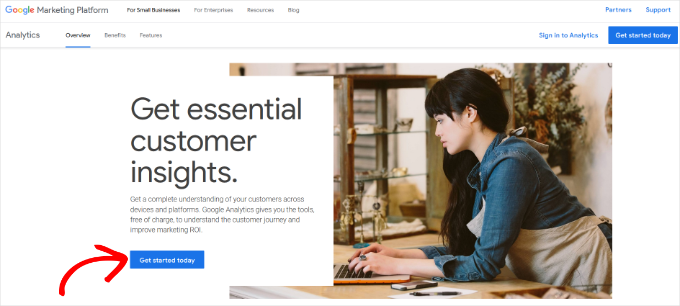
Next, you will be asked to log in with your Google account.
If you already have a Google or Gmail account, then you can use that to sign in. Otherwise, you can go ahead and create a Google account for yourself.
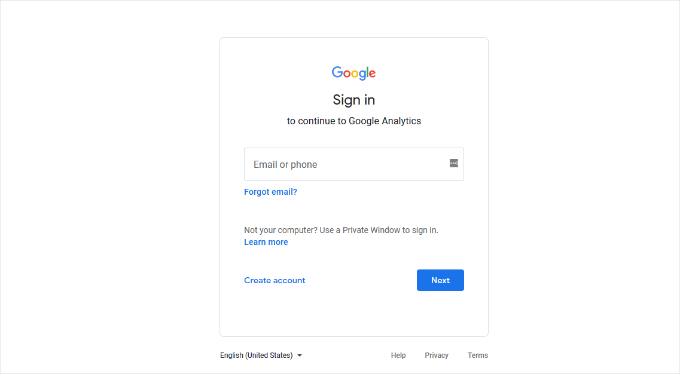
Step 2: Once you have signed in with your Gmail account, you will see a welcome screen like the one below.
This is where you will sign up for Google Analytics with your Gmail account. Go ahead and click the ‘Start measuring’ button.

After that, you will be asked to provide an account name.
This name will be used internally, so you can use anything, like your business name.
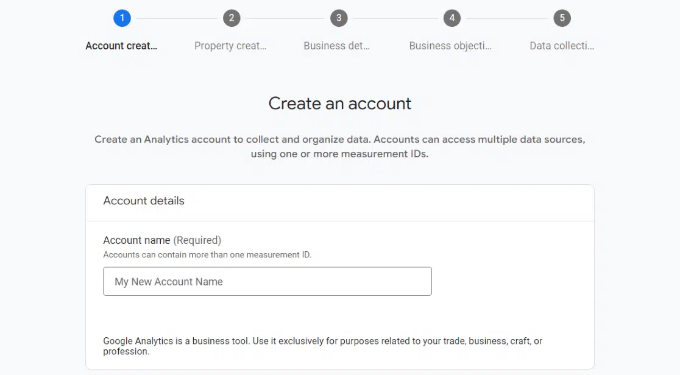
Google Analytics will also show multiple account data-sharing settings.
These settings give you control over sharing your Google Analytics data. You can keep the default settings and move on to the next step.

Step 3: On the next screen, you will need to create a Google Analytics property.
Google introduced a new version of Analytics called Google Analytics 4 or GA4. It’s the latest version that tracks your website and mobile apps in the same account. Plus, you get new features, metrics, and a different interface for your reports.
Go ahead and enter a property name and select your reporting time zone and currency. Then click the ‘Next’ button.
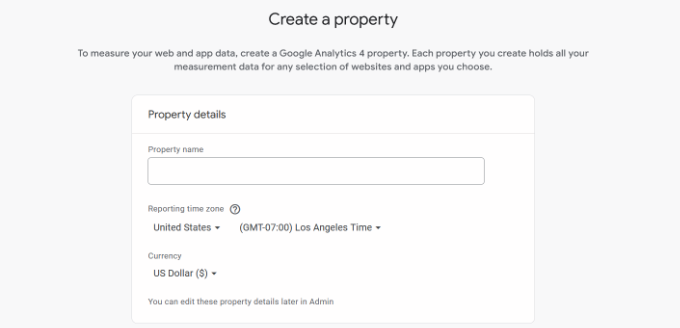
On the next screen, you’ll need to select an ‘Industry category’ from the dropdown menu for your website and choose a ‘Business size’ from the given options.
When you are done, just click the ‘Next’ button.
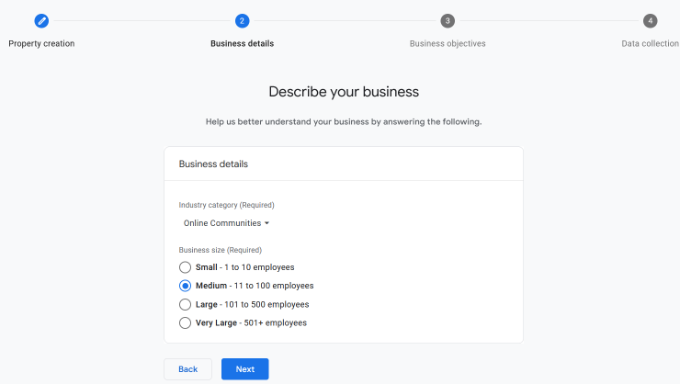
Next, you’ll need to choose business objectives and select how you intend to use Google Analytics with your business. This will help get personalized reports for your business.
For instance, there are options like generating leads, driving online sales, raising brand awareness, examining user behavior, and more.
You can choose multiple options or all of the given options that meet your needs. We recommend selecting the ‘Get baseline reports’ option so that you get all the Google Analytics reports populated in your account.
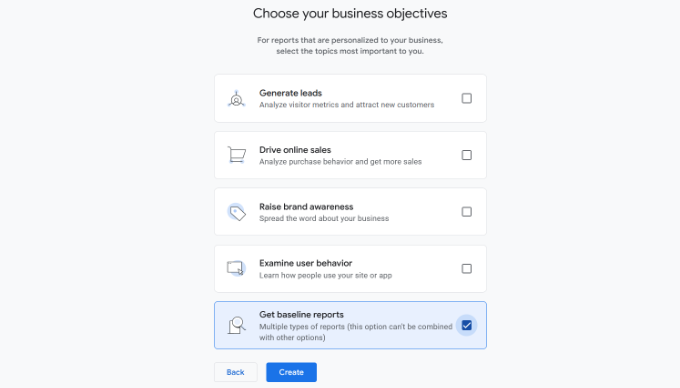
When you are done, simply click the ‘Create’ button.
Step 4: Now you will be presented with your Google Analytics Webs stream options.
Since we are setting up Google Analytics for a WordPress site, go ahead and select ‘Web’ as the platform.
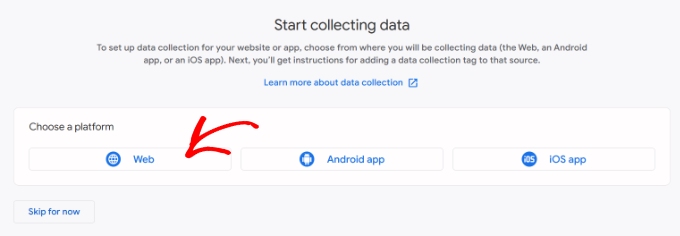
After that, you’ll need to enter your website URL and Stream name.
By default, Google Analytics will have an ‘Enhanced measurement’ option enabled. This allows you to track pageviews, scrolls, outbound clicks, file downloads, and more in Google Analytics.
📝 Note: If you plan to use the MonsterInsights plugin, then you should turn off the ‘Enhanced measurement’ option. Otherwise, the plugin will collect and display double the amount of data.
Next, you can click the ‘Create stream’ button.
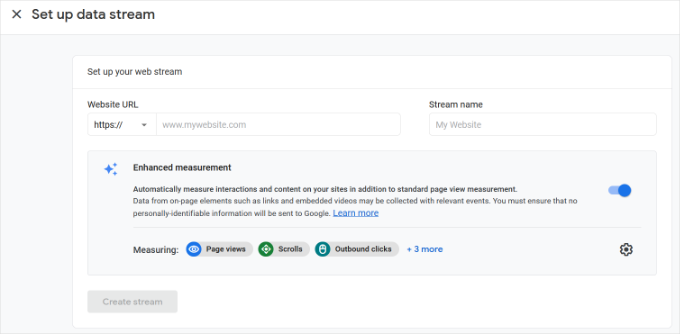
You can now see your Stream name, URL, ID, and Measurement ID.
It will also show different enhanced measurements that it will record.
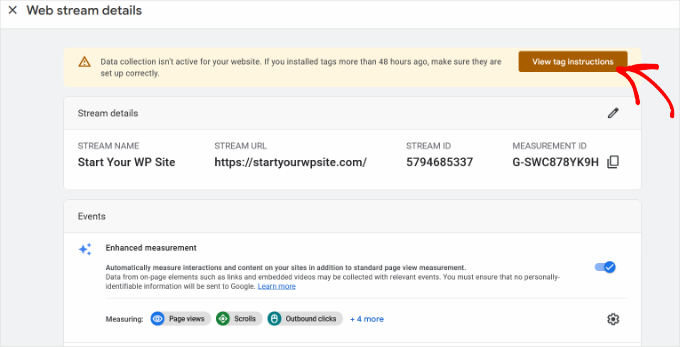
At the top, you will also see an alert bar that will show you how to add Google Analytics to your WordPress site.
Go ahead and click the ‘View tag instructions’ button. You should now see different ways to add the Google Analytics tracking code to your WordPress website.
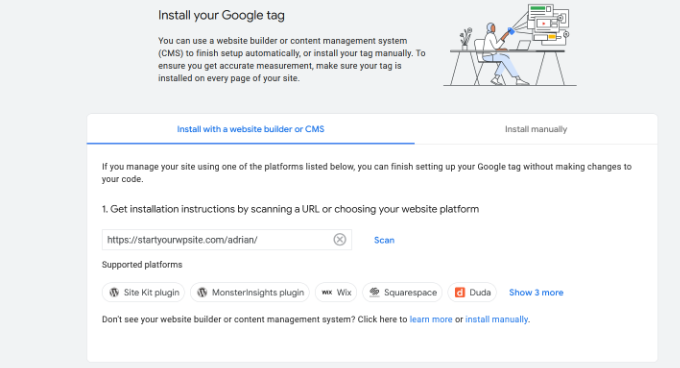
Next, you can switch to the ‘Install manually’ tab.
You’ll then see the Google Analytics tracking code.
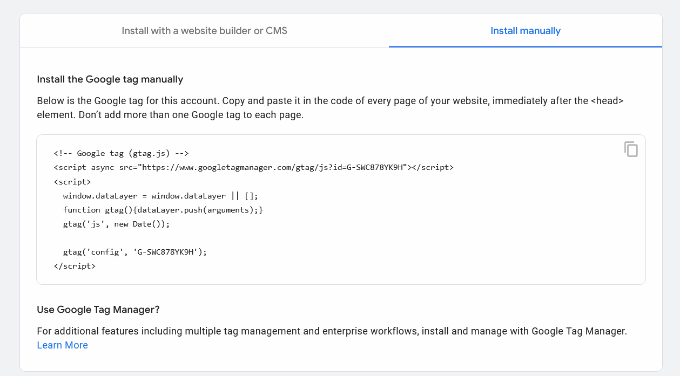
Go ahead and copy this tracking code because you will need to enter it in your WordPress site, depending on the method you use below. You can also simply leave this browser tab open and switch back to copy the code when needed.
We suggest leaving the ‘Analytics’ browser tab open. It’s because you may need to revisit it once you have installed the code on your WordPress site.
Now that you have set up a Google Analytics account, let’s take a look at how to install Google Analytics in WordPress.
How to Install Google Analytics in WordPress
There are a few different ways to set up Google Analytics in WordPress. We will show you three methods, where the first option is the easiest and the last is the hardest.
You can choose the one that best suits your needs.
💡 Pro Tip: You need to use only one of these methods on your website to avoid double tracking of pageviews in your Google Analytics account.
Method 1: Google Analytics for WordPress by MonsterInsights
MonsterInsights is the most popular Google Analytics plugin for WordPress. Over 3 million websites use it, including the likes of Bloomberg, PlayStation, Zillow, WPBeginner, and more.
It is the easiest and, by far, the best way to add Google Analytics to WordPress (for all users, beginners, and experts alike). MonsterInsights is available as both a paid premium plugin and a free version.
At WPBeginner, we use MonsterInsights for various tracking tasks, such as form submissions, CTA button clicks, and referral link performance. Learn why it’s a great plugin in our complete MonsterInsights review.

In this tutorial, we will be using the MonsterInsights free version.
You can use the MonsterInsights Pro version if you want more advanced features like eCommerce tracking, ad tracking, author tracking, and so on. The process of setting them up is the same.
Let’s get started.
The first thing you need to do is install and activate the MonsterInsights plugin. For more details, see our step-by-step guide on how to install a WordPress plugin.
Upon activation, the plugin will add a new menu item labeled ‘Insights’ to your WordPress admin menu, and you’ll see a welcome screen. Go ahead and click the ‘Launch the Wizard’ button.

Clicking on it will open the MonsterInsights setup wizard.
First, you will be asked to choose a category for your website (a business website, blog, or online store). Select one and then click on the ‘Save and Continue’ button.
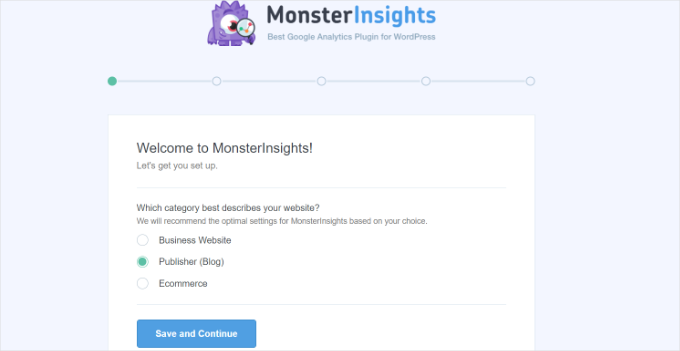
Next, you need to connect MonsterInsights with your WordPress website.
Simply click on the ‘Connect MonsterInsights’ button.

This will take you to Google accounts, where you will be asked to sign in or select a Google account if you are already signed in.
Go ahead and choose your Google account or enter your email to sign in.
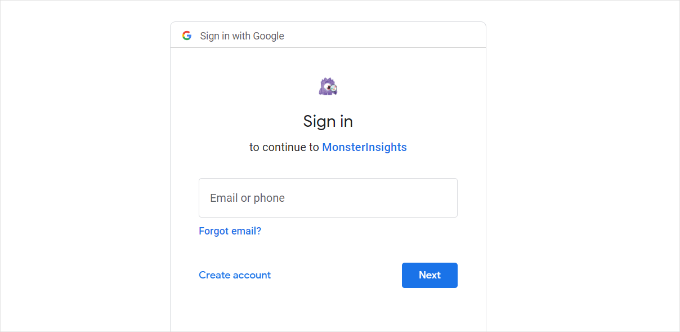
Next, you will be asked to allow MonsterInsights to access your Google Analytics account.
Click on the ‘Allow’ button to continue.
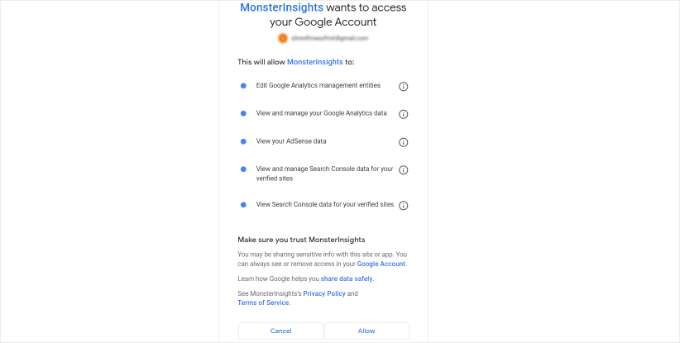
The next step to completing the connection is to select the profile you want to track.
You need to select your website here and then click on the ‘Complete Connection’ button to continue.
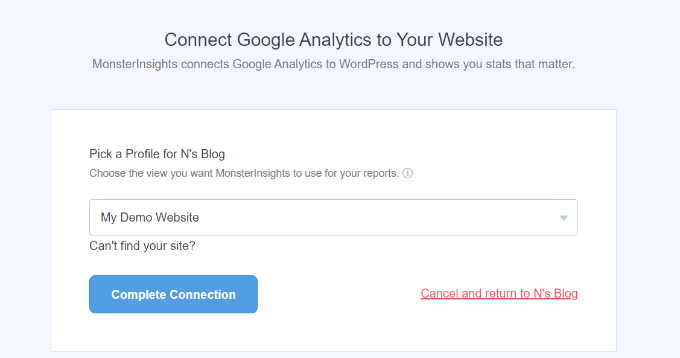
After that, simply click on the ‘Complete Connection’ button to continue. MonsterInsights will now install Google Analytics on your website.
Next, you will be asked to select the recommended settings for your website.
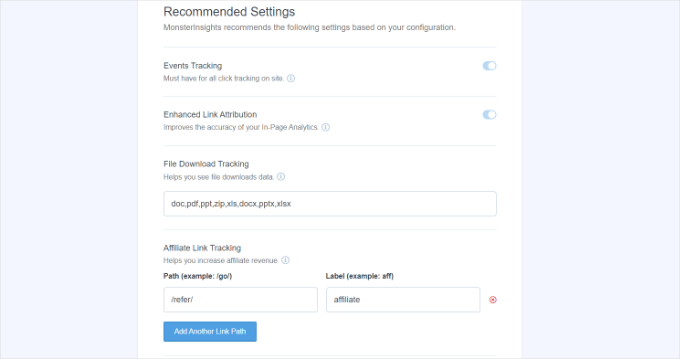
The default settings will work for most websites. If you use an affiliate link plugin, then you need to add the path you use to cloak affiliate links. This will allow you to track your affiliate links in Google Analytics.
MonsterInsights will also ask who can see the reports. You can choose different WordPress user roles.
Once you are done, just click on the ‘Save and Continue’ button to save your settings.

Next, MonsterInsights will show you a list of website tracking features you would like to enable.
You can scroll down and click on the ‘Continue’ button or the ‘Skip for Now’ option.
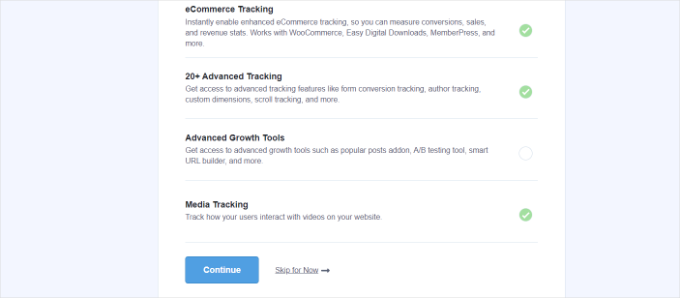
On the next screen, MonsterInsights will show that you’ve successfully set up Google Analytics tracking.
You can see that Google Analytics is connected, the tracking code is installed, and data is now being collected.

Next, you can scroll down and see a field to enter your license key.
Go ahead and click the ‘Complete Setup without Upgrading’ option for now.

You’ve successfully added Google Analytics to your WordPress website.
Disable Enhanced Measurement in Google Analytics
Now, if you created a Data Stream in GA4 on your own instead of letting MonsterInsights create one, then you’ll need to switch off Enhanced Measurement.
That’s because MonsterInsights adds multiple custom-enhanced tracking features. Leaving the Enhanced Measurement option enabled will skew your data and show incorrect results.
First, you can head to the Google Analytics tab or window in your browser. From here, click on the ‘Admin’ settings option in the bottom left corner.

Once you are on the ‘Admin’ page, you’ll see different settings.
Simply click on the ‘Data Streams’ option.

Next, you’ll see your Data Streams.
Simply select the data stream you connected with MonsterInsights.
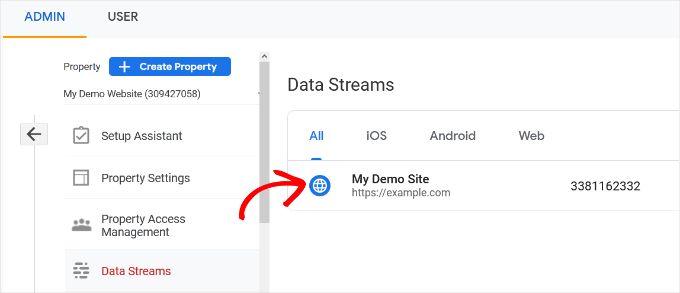
On the next screen, you will need to disable the ‘Enhanced measurement’ option.
To do that, simply click the toggle.
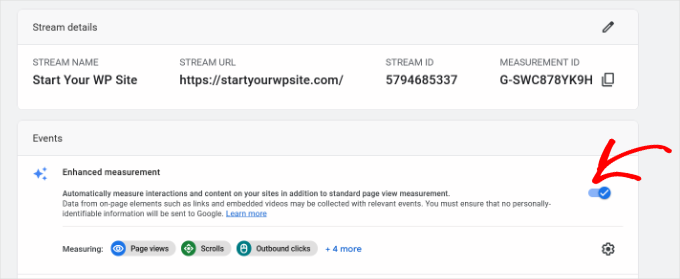
Next, a popup window will open, confirming that you’d like to turn off the enhanced measurement.
Go ahead and click the ‘Turn off’ button.
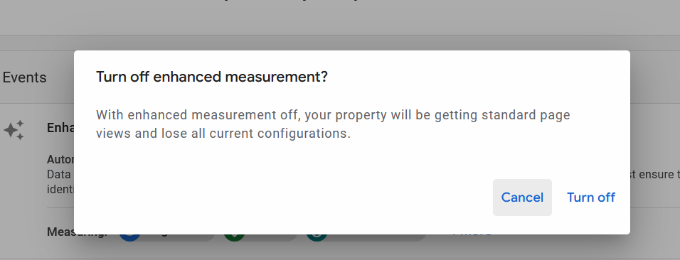
Change Data Retention Settings in Google Analytics
By default, Google Analytics will set the data retention setting to 2 months. However, you can change this so that you can use your data in custom reports beyond 2 months.
First, you need to head to Admin » Data Settings » Data Retention in Google Analytics.

Next, you can click the ‘Event data retention’ dropdown menu.
From here, simply select the ’14 months’ option and click the ‘Save’ button.
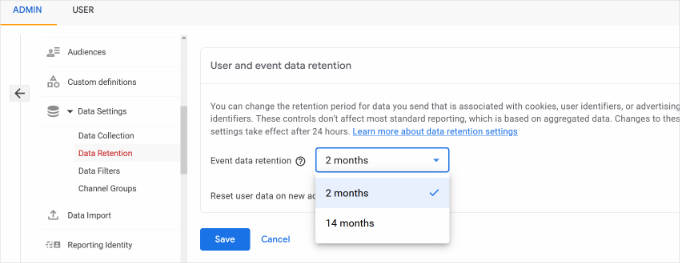
Remember, it will take Google Analytics some time before showing your stats.
💡 Pro Tip: Google Analytics lets you extend data retention to 14 months, but even if you choose the default 2-month option, privacy rules like GDPR still apply.
For that reason, you still need to get user consent before tracking, and it’s a good idea to mention how long you keep data in your privacy policy.
Not sure how to get started? Check out our guide on how to add a cookie popup in WordPress for GDPR/CCPA.
View Google Analytics Reports Inside the WordPress Dashboard
The best thing about MonsterInsights is that you can view your Google Analytics reports inside your WordPress dashboard.
Simply visit the Insights » Reports page to check out a quick overview of your analytics data.
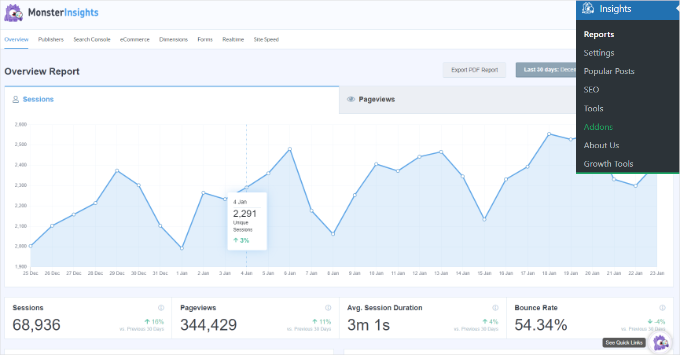
You can also add annotations directly to your MonsterInsights reports to record key changes you make to your website.
For example, you can add a note when you publish a new blog post, add a new landing page, and so on. This makes it easy to track how these events impact your traffic.

For more details, see this guide on how to get GA4 site annotations in WordPress.
You can even just ask MonsterInsights about the website stats you’re interested in, thanks to the new Conversations AI feature.
For instance, if you have an eCommerce website, you can ask how much revenue you made from a product in a specific time period.
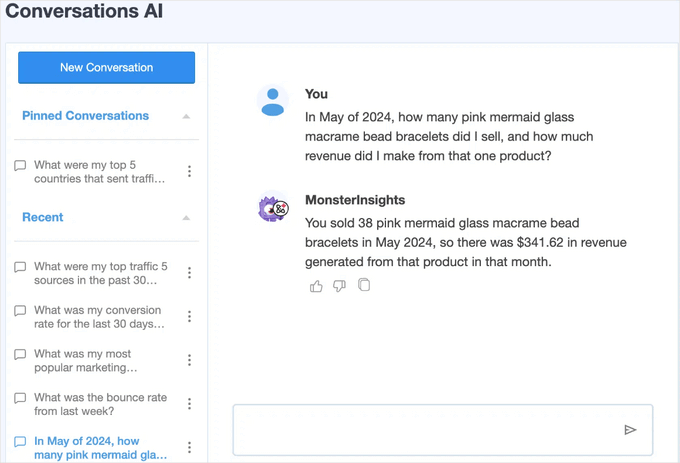
This is much easier than searching through your reports to find the data you need, especially if you’re just starting out with analytics.
In addition, MonsterInsights comes with a Popular Posts addon that allows you to show your top-performing content to boost your traffic and pageviews.
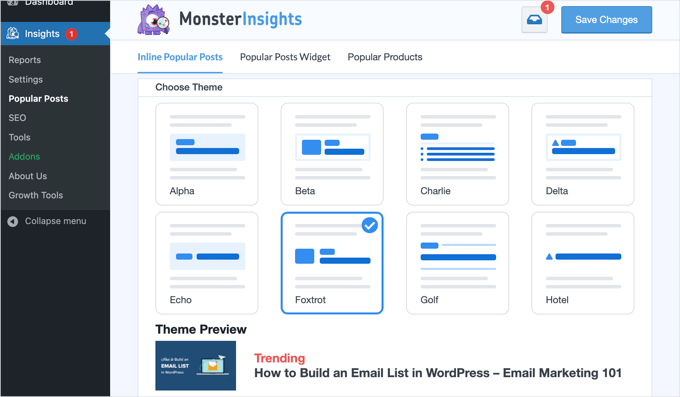
You can use it to automatically add inline popular posts links to boost engagement.
If you are running an online store, then it can also automatically add your top-performing products at the end of each blog post to boost sales:

If you run a WordPress blog, then the Page Insights addon will be super helpful.
Once installed, it will automatically add your blog stats in your ‘All Posts’ screen, the front end (while logged in), and the content editor screen.
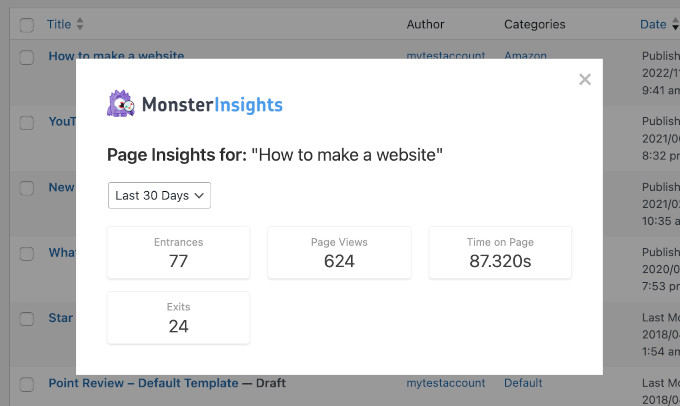
🌟 Insider Note: MonsterInsights was formerly known as Google Analytics for WordPress by Yoast. WPBeginner’s founder, Syed Balkhi, acquired the plugin in 2016 and rebranded it to MonsterInsights. Now, it is part of our family of premium WordPress plugins.
Method 2: Install Google Analytics in WordPress With WPCode
In this method, we’ll show you how to manually install Google Analytics in WordPress. We’ll use WPCode to add the GA4 tracking code to your site’s header.
⚠️ Before we start, do note that this method is not as good as MonsterInsights because you will not be able to do advanced tracking configuration. Also, you will not be able to view Google Analytics data in your WordPress dashboard.
The WPCode plugin lets you safely add custom code snippets to your WordPress site without editing theme files.
Some of our business partners use WPCode to manage tracking scripts, custom features, and other advanced settings, and it’s been working exceptionally well. To learn more about the plugin, check out our full WPCode review!

First, you will need to copy your Google Analytics tracking code (Global site tag) that you copied in Step 4 earlier when creating a Google Analytics account.
Here’s what it might look like on the interface:

Next, you need to install and activate the WPCode plugin. For more details, see our step-by-step guide on how to install a WordPress plugin.
📝 Note: You can use the free WPCode plugin to install the Google Analytics tracking code.
But upgrading to WPCode Pro unlocks more powerful features — like complete revision history to help you track changes and code scheduling to automatically enable or disable snippets at specific times.
Upon activation, you need to visit the Code Snippets » Header & Footer page. Here, you must paste the Google Analytics tracking code that you copied earlier into the ‘Header’ section.

Don’t forget to click the ‘Save Changes’ button to store your settings.
That’s all, you have successfully installed Google Analytics on your site.
Method 3: Install Google Analytics in WordPress Theme
This method is for advanced users who are familiar with the code. It is somewhat unreliable because your code will disappear if you switch or update the theme.
We almost never recommend using this method.
If this is your first time adding code to your WordPress files, then you should check out our guide on how to copy and paste code snippets in WordPress.
First, you will need to copy the Google Analytics tracking code that you copied in Step 4 earlier. You can view it in the Web Stream Installation section under the ‘Install manually’ tab.

Now, there are two common ways to add this code to your WordPress theme files. You can choose either one of them (not both).
1. Add Code in header.php File
Simply edit the header.php file in your WordPress theme and paste the Google Analytics tracking code that you copied earlier right after the <body> tag.
Don’t forget to save your changes and upload the file back to your server.
2. Add via Functions File
You can also add Google Analytics tracking code to the WordPress functions file. It will then automatically add the tracking code to every page on your WordPress site.
You will need to add this code to your theme’s functions.php file.
<?php
add_action('wp_head', 'wpb_add_googleanalytics');
function wpb_add_googleanalytics() { ?>
// Paste your Google Analytics tracking code from Step 4 here
<?php } ?>
Don’t forget to replace the ‘Paste your Google Analytics tracking code from Step 4 here’ section in the above snippet with your Google Analytics code.
Viewing Reports in Google Analytics
Google Analytics is capable of showing you a treasure trove of data collected from your stats. You can view this data by visiting your Google Analytics dashboard.
You will see the built-in Google Analytics reports in the left column. Each section is divided into different tabs, and clicking on a tab will expand it to show more options.
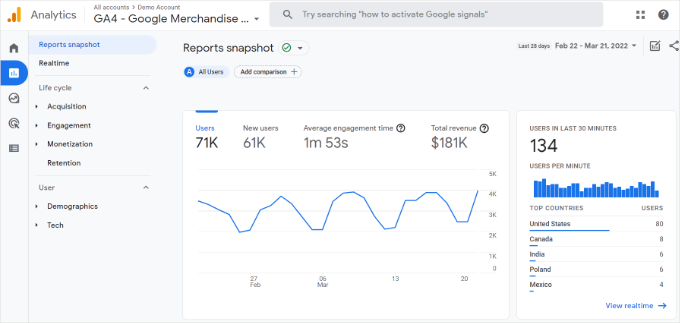
Google Analytics 4 reports are a bit different from previous Universal Analytics reports. In the left column, you’ll see a dedicated Reports option. The reports are grouped together under 2 broad categories, including Life Cycle and User.
One of the most noticeable differences you’ll find in GA4 reports is that there’s no bounce rate metric. Other than that, you’ll find a new reporting interface, new metrics like engagement time, no goals in GA4, and more.
Here’s a breakdown of the different reports in Google Analytics 4:
- Realtime report is similar to Universal Analytics and shows active users on your site in real time.
- Acquisition report shows which medium users use to find your websites, like organic, referral, email, and affiliate.
- Engagement report shows conversions and events that take place on your site.
- Monetization report shows all your eCommerce data in one place, along with new reports like in-app purchases and publisher ads.
- Retention report basically shows new vs. returning visitors and helps you get insights about user retention.
- Demographics report helps you see website traffic from top countries, cities, and more. It also shows gender breakdown and interest reports.
- Tech report shows which device, browser, operating system, app version, and screen size people use the most to view your website.
Making the Most Out Of Google Analytics
Google Analytics is an incredibly powerful tool with tons of awesome features. Some of them are quite obvious and easy to use, while others require some additional setup.
Here are some of the resources that will help you make the most out of Google Analytics reports.
- Track user engagement in WordPress with Google Analytics
- How to see search analytics in WordPress
- Track outbound links in WordPress
- How to keep personally identifiable info out of Google Analytics
- How to set up WordPress form tracking in Google Analytics
- Track WooCommerce customers in Google Analytics
- How to easily get a custom email alert in Google Analytics
Google Analytics works best with Google Search Console (formerly Google Webmaster Tools). It allows you to see how your website is doing in search results. See our complete Google Search Console guide to learn how to use it to grow your website.
If you want to improve your WordPress SEO rankings and get more traffic, then we recommend using the AIOSEO plugin for WordPress, which is an all-in-one SEO toolkit.
There’s also a free version of AIOSEO that you can use, too.
This plugin will help you fully optimize your WordPress site with proper schema markup, sitemaps, and everything you need to improve your SEO rankings.
Video Tutorial
Before you go, don’t miss our video tutorial on how to install Google Analytics in WordPress to see the process in action. ▶️
We hope this article helped you learn how to install Google Analytics in WordPress. You may also want to see our guide on Google Analytics vs. Jetpack Stats or our ultimate guide to GA4 in WordPress for beginners.
If you liked this article, then please subscribe to our YouTube Channel for WordPress video tutorials. You can also find us on Twitter and Facebook.





Alexia
I’m trying to install the GCE on my Wordpress site, and I’ve got the code installed in the of the theme header.php. The code validates for both pages on Google Analytics. But when I try to then load my “original” page on my site, I get a 404 error. I’ve been researching and it seems like it is something to do with the server security, but my contact at our host is having trouble determining how to address this. Do you have any specific suggestions for what server files / permissions needs to be modified to get this to work? Thanks!
Brent Sheive
Thank you so much!
JayMichaelsSDM
You just saved me tons of time …ha! So simple
g
You don’t need to pasted into the Tag, it’s better to paste into the tag right before
WPBeginner Staff
its located under the main Settings menu in WordPress admin menu.
Rebecca Hauptman Cashman
I installed the plugin, and the next step is to go to the settings area, however this plugin doesn’t have a settings area. There is the option of “deactivate” and “edit” but other plugins have the “settings”, “deactivate” and “edit” links… this one doesn’t. What do I do now?
Thanks
Jon
Awesome article! really helped me install google analytics for my blog
Nick
Thanks for the article. It helped with a few issues I’ve been having. First and foremost of course was not having the code in my site. I was able to get it working with both functions.php and the recommended header/footer plugin.
elenaleksandra
Hi! Thanks. I use different analytics tools and they give me different reports. Who to believe?
Darshan Paladiya
I think you should trust Google. That is because apart from directly added tracking code, no other company can has as much data about your website as Google has.
And apart from that, most of the organic traffic from any website is mostly from Google. So original Google analytics data can be more useful in creating a solid strategy that impacts your Google results compared to any other service.
That’s how I think, I am not an expert but surely an SEO with 18 months of experience. Anyway good luck with your site.
Rodger
Regarding Insert Headers and Footers method, Would be worthwhile to advise on pasting the script in the Insert Header or Insert Footer space – These scripts will be printed in the section. OR These scripts will be printed above the tag.
Ray Uotila
Paste into the header, footer or both in the plugin settings?
Giovanni
I pasted my Google Analytics code using Insert Headers and Footers, but the status of my tracking ID is still showing not installed. How long does this take to show it has been installed or did I do anything wrong?
Molly Fabs
I’ve added my tracking code to the header.php file of my theme (suits), by manually pasting it in. I’ve tried it right after the body tag, as you suggest, and also right before the close of the head tag, which I’ve seen advised elsewhere. (not pasting the code twice, just trying it in each location by itself). In both instances, my Analytics account says: tracking not installed. Any idea why GA isn’t seeing my code? Thanks in advance!
WPBeginner Support
Give it atleast a day.
Admin
Devesh
Hello,
I have created a blog on wordpress.com, but where will be paste code of google analytics in wordpress.com ?
WPBeginner Support
Devesh, this guide is for self hosted WordPress.org sites. Please take a look at WordPress.org vs WordPress.com guide to understand the difference.
Admin
Jim
Hi,
I inadvertently have the Google Analytics script in my home page twice. Once put in by someone helping and another by a plug-in.
I’ve been able to view/modify the HTML in the past, I think, I but can’t for the life of me find where to access the full HTML.
I can see visual vs text but don’t believe that gives me enough of the HTML to modify/remove one of the Analytics scripts.
I’ve also looked at Appearance>Editor but that seems to be about themes..
I can see what I want to remove if I go to a “view source” page looking at my page from a web browser.. but can’t find it to remove it through WP.
Any help would be appreciated.
thanks
Jim H
PS I am using a Genesis theme News Pro and Premise..
Petia Warzel
What theme is this website? BTW thanks for the article I just started my own blog.
Petja
Amber
Thank you for this! I have a question. Google analytics has me at 3 visitors and then 0 visitors where wordpress has me at 30 and 50 for those days. I did just start my blog. Why would GA not be picking it up? Thanks!
WPBeginner Support
Amber, give analytics sometime. When you first install analytics there is usually a delay in reports.
Admin
@ginabegin
How are you seeing analytics from Wordpress itself? I thought this was just available on Wordpress.com sites, not .org, and that Google Analytics was only available for .org.
Darshan Paladiya
Hey @ginabegin:disqus, I think you should try installing plugin, either “Jetpack” or “Google Analytics Dashboard for WP”.
Both of them make site analytic available in Wordpress.org
Becky Manuel
Hi,
I’m ready to paste my code, and you said do it after the body tag, but I’m not sure exactly where you mean. As in, hit return after I see the words <body >
then paste?
Or paste at the bottom of that whole block (which would be the end of the page) as the last item on the whole page?
Please help thank you
WPBeginner Support
you need to paste it immediately after <body> tag.
Admin
Sophie
Where is the tag? I can only see once space for scripts in header and another space for scripts in footer?
Darshan Paladiya
Sophie, don’t mind it. Usually you will see only blank space for scripts. Still it works. The case depicted by Becky is exception.
Just give your Analytics some time after installing script in those fields.
Bozo Pub
Hello,
thanks for the informative article. I’m interested in following:
I had a website in Joomla, with already inserted analytics code. Now, I have created a blog in WP, with the same name, but with changed adress (now it have /blog in the extension).
What is the procedure to keep running the existing code because I want to keep running my statistics record from previous site.
Thanks
Darshan Paladiya
Simply, you can’t do it. Google analytics data of one url can’t continue with another one.
Jerzy
Hi,
If the WP theme I’m using as a Google Analytics configuration already built in, I am correct in assuming that I don’t need to follow the 3 steps of pasting code in your tut above?
Thank you.
WPBeginner Support
Yes, you can follow the instructions provided in your theme’s documentation.
Admin
Darshan Paladiya
Still you will have to add tracking code somewhere, your theme providers won’t give it usually. They just give you copy paste interface that is easier than coding work.
Kathrine K.
Hi!
Thanks for a wonderful guide!
I was wondering what happens if I have my code in the header.php right before the ? I read another guide before yours, stating that this was where to put it.. That’s where it is now and my analytics seem to work?
Best,
Kathrine
WPBeginner Support
If it is working, then it is good.
Admin
Jenna
I installed the plugin but there was no settings page. Is there a certain area in the code that I paste the script?
Thank you!
Nishith G.
I started it 1 hour ago and finished it now. Thanks to this beautifully crafted article that helped a newbie like me to finalize each and everything so smoothly.
Waiting for the data to populate in GA dashboard now.
God bless you Syed.
Rosanne
Hi, I downloaded the plug in and followed the directions listed, but on GA it still says that it’s not installed…I’ve given it 12 hours…Any trouble shooting ideas? I chose to paste the script into the footer and made sure I hit save after I copied over the script.
Crissy
I had the same problem. I’ve tried other plug ins and they didn’t work either.
Ronald
I have just started building a new site on WordPress and am building it on my computer as a local host first before I transfer it over to an online host. What I want to know is can/should I activate the Google Analytics plugin now or wait until I have uploaded it to a online host.
WPBeginner Support
Wait until you upload it online.
Admin
Lucia
Thank you so much for these clear and detailed instructions. I did everything you said and it worked out great up until pasting the code into the header and footer plugin. Because after I do that, the code is actually visible in the header of my website. What am I doing wrong?
Thanks for your support!
WPBeginner Support
Lucia, you can try pasting the code using the direct paste method or use functions.php method.
Admin
Nick
You may also be posting code which is missing the tag. This will cause PHP to read it as regular HTML depending on the particular situation and very likely could be the reason you’re seeing plain text at the top of your site after posting a script in to the header.
Norman Weathers
I’ve just started a wordpress site at quriousity.com and need to track my traffic. Your advice is invaluable.
Carlos
Hello,
Thanks for the informative article.
I followed the instructions for CapitalHustle.com however the Google Analytics still shows “Tracking Not Installed.”
I pasted the code into the header and footer sections of the plugin settings. Am I missing something?
Thanks!
Carlos
David Jonsson
do i need to put the analytics code on each blog post every time i post a blog?
WPBeginner Support
No you don’t. If you paste it correctly then it should track all your website.
Admin
E.S. Ivy
The headers and footers plug-in is really nice so that I don’t have to worry about messing up the rest of the code!
I was wondering, am I right that this also means that a Wordpress upgrade won’t make these changes disappear? I keep putting of learning how to make a child theme. And I think this was the one change I had made to my code previously. I forgot about it and then it disappeared with a Wordpress update.
And I think this was the one change I had made to my code previously. I forgot about it and then it disappeared with a Wordpress update.
Dave Jackson
on a site I manage, I have installed google analytics but despite having visited the site using my phone so it is from a different ip address from where I am managing it, it still shows up as there being no traffic. How long after installing do I have to wait before I start seeing results?
Hemant
Hi,
This article is really helpful, thanks for sharing. I am looking forward to read more articles in future. Keep writing!!! cheers.
Paige
I have recently switched from Blogger to WordPress and want to transfer my Google Analytics over. How do I do this?
Dan
I used the plug-in method to install google analytics, but it keeps saying that tracking is not installed. I copied the tracking code from google and pasted it directly into the settings for the plugin insert header and footer. Any suggestions for what I can do to fix it or any idea why it is not working? My website is http://www.thesimplestform.com/
The tracking code shows up when you do view source.
Dan
I used the plug-in method to install google analytics, but it keeps saying that tracking is not installed. I copied the tracking code from google and pasted it directly into the settings for the plugin insert header and footer. Any suggestions for what I can do to fix it or any idea why it is not working?
E.S. Ivy
I was having this problem too. Not sure if it was just time, but I also have W3 Total Cache installed and it might have helped to empty the page cache.
Craig
How do I know if this has worked and is active?
Cheers.
WPBeginner Support
Log in to your Analytics dashboard and from the top menu click on Admin. Select the account and property you want to check and then click on Tracking Info you will be able to see a status message like Status: Receiving Data
Admin
Debbie Pugh-Jones
I have a wordpress.com site foweyholiday.co.uk. Can I use Google analytics on this as I read somewhere that you couldn’t.
thanks
WPBeginner Support
You can not use Google Analytics on a WordPress.com site. Please check out our guide on the difference between WordPress.com and WordPress.org
Emmanuel Rosani
Thank you for this awesome blog post! I’ve successfully installed Google Analytics to my new first Wordpress site..
Cheers,
Emman
zohar
thank you, this was very helpful!!
Heather
very helpful! thanks!
ahsan karim
you are great man. I have no words to thank you
Kat
I have Google Analytics installed on my web site, and i’ve just created a folder area to house our new blog. Do I need a separate tracking code to track the blog statistics, or just install same site-wide tracking code through the header/footer plug-in? If so, where in Google Analytics would I view the blog stats specifically? Thanks for your help!
WPBeginner Support
if your new blog is actually a separate website on its own, then you better create a new project in Google Analytics. If it is under the same website but in a subdirectory then you can use the same analytics code.
Admin
Samantha
Thank you, this was very helpful. I was really confused about how to get that code into “every page on my website” without going though a bunch of work, but that “insert header and footer” plugin is a really fast and easy way to do it! Thanks again,
-Samantha
Carole Rains
I have been using Google Analytics for about 6 months, but want to utilize the Demographics and Interests data. I keep getting a message that I need to implement a code change to allow that data to be accessed, but I’m not sure how or where to make this code change. Can you provide some guidelines please?
WPBeginner Support
Carole when you first integrated Google Analytics in your website you would have inserted a piece of code somewhere on your site. Now you need to update that code and replace it with the new one.
Admin
Stephanie
If using the “Insert Header and Footer” plugin, should the Google Analytics code snippet be installed in BOTH Header and Footer or either?
Thanks
WPBeginner Support
either
Admin
paola
hi! when you add the code in the functions.php, is not missing a closing php somewhere?
WPBeginner Support
Paola, functions.php file does not have a closing php tag at the end.
Admin
Brooke Muckersie
Hi there, just one thing… is this an error in your post?
“Direct Paste Method
Copy the code that you received in Step 6, and paste it in your theme’s header.php right after the tag.”
Shouldnt that be ‘before the tag.’ (not after)?
WPBeginner Support
Brooke, yes it is right after the
<body>tag not before it.Admin
Hugh
Doesn’t Google Analytics make asynchronous calls? I guess that’s why instructions say “Paste your snippet (unaltered, in it’s entirety) into every web page you want to track. Paste it immediately before the closing tag.”
Yoast’s plugin Google Analytics for WordPress also loads the tracking code in the header
vivek
I used the plugin you recommended and i doubt that is it important to paste the whole Google Analytics code in both header and footer boxes?? or header is enough??
Shiv Saroya
As we all know Google Analytics has changed it dashboard like anything. day by day it becomes more user friendly. Nice post. Keep sharing like this.
Ashish kausha
it is nice and very helpful for me………..
Hayley Reed
Hi there
I am using the header and footer plugin for GA in my wp blog and was wondering if there was any way to exclude pages such as the legal pages etc
thanks
WPBeginner Support
By default header and footer are there on all pages in most themes and Insert Headers and Footers plugs the code into header and footer functions of WordPress.
Admin
Hugh
You could try using filters (Admin > Views > Filters). A custom filter excluding the page title field may work
Another option is including the GA code conditionally, of course, in this case you can not use a plugin